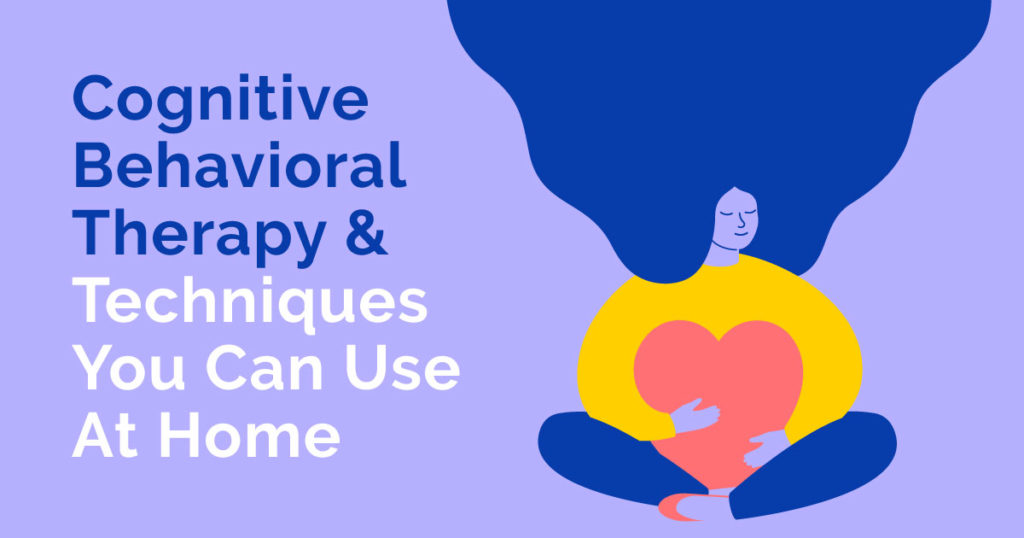Cognitive Behavioral Therapy & Techniques You Can Use At Home
August 24, 2021

Throughout our lives, and especially over the course of the last year, many of us have moments or periods of time where we feel particularly stressed or anxious. The source of these feelings could be an external factor, like a major change in routine, or something more personal, like feeling compelled to overexert yourself. Whatever the source or whatever the feeling, we can address it better if we take time to reflect on how our behaviors, thoughts and emotions affect one another.
A popular tool among mental health professionals, cognitive behavioral therapy, often referred to as CBT, helps individuals examine their thoughts and recognize their behavioral patterns. Kory Carey, Ph.D., HSPP, the deputy director of policy and division collaboration at the Indiana Division of Mental Health and Addiction, has an extensive background as a trained counseling phycologist. She shares the value of CBT as a professional treatment, as well as some techniques of CBT that we can apply to our lives.
CBT is one of the most widely used, researched and effective forms of treatment in therapy and psychotherapy. It helps people examine their thoughts and determine how detrimental thinking affects their behavior. When someone undergoes treatment with a professional, they will uncover and identify their thinking errors and learn how to navigate them.
There are several strategies and techniques that individuals who are not currently in treatment can implement. Dr. Carey reminds us, “Even as we talk about examining your thoughts, it is still a process. It takes learning your thoughts.” There are ways to achieve some of the benefits of CBT while not necessarily knowing all the ins and outs, that is where these techniques can come into play.
CBT TECHNIQUES YOU CAN PRACTICE AT HOME:
Journaling – writing about what’s happening internally, you can slow down and become aware of your feelings. There are a variety of guided templates available online if you aren’t sure where to start. A simple online search can provide a variety of journaling templates. We encourage you to search and find one you’re most likely to use, or simply start by taking a pen to paper and writing down your throughs.
Stress Management Apps – there are apps with stress reduction techniques that you can use. These techniques are tied to mindfulness. There are a variety of apps available across all platforms that are effective for tracking your mood or providing stress management tips. Several well-regarded apps for stress management include: UCLA Mindful, Smiling Mind, Stop, Breathe, and Think, and Insight Timer
Reframing – By reframing negative thoughts into more realistic thoughts, we can challenge our way of thinking. An example: “I am returning to the office and feeling doom and gloom about my commute.” This can be reframed by finding something true and positive about the experience, “I am returning to the office and while that will be an adjustment, I am looking forward to wearing my favorite clothes again.”
When we slow down or disrupt our routine thought processes, we can take stock of how we may be enhancing our stress or anxiety. By becoming aware of what’s going on in your head, you can learn to accept your thoughts for what they are without feeling the need to act, change or create meaning from them. Dr. Carey explained, “Once you identify a problem, you have the authority to challenge and change it.” She recommends keeping the following in mind:
Listen to Yourself – a lot of times we’ll go on and on, knowing something is wrong, and we might develop a habit we don’t actually like. If we can pay attention and believe in ourselves when we know something is wrong, we can adjust that. It’s like our physical health, we need to take it seriously.
Be Equally Attentive to True Challenges – when we notice we are not doing well, we need to start there and listen.
Know What Works for You – For some, professional help is necessary; for others, reconnecting to a social support group or grounding yourself in quiet time can be enough to help you. Be OK doing what works for you. Dr. Carey placed importance on knowing our own limits, “Don’t compare what you need to what someone else needs.”
Be Proactive in Self Care – Understand we don’t need to wait for a breaking point. Take time off from work when you need it, slow down when you need it, apply these techniques when you need. If we take care as we go, it’s easier to maintain a healthier mental space than to fix something bigger.
Sometimes, it can be hard to recognize that your mental health is being challenged. Check in with yourself using this Mental Health Self-Assessment tool.
If you’re having intense emotions, severely negative or paranoid thoughts or have considered harming yourself or others, seek help from a professional right away. Call 2-1-1 to speak to a trained counselor who can connect you to help in your area.
Call 211
To be able to focus on mental health, your basic needs (shelter, food, clothing, health care, etc.) must be met first. Indiana 211 is a free, safe and confidential way to connect to resources from around the state and in your community.
If you need support, call 2-1-1. The resources on Indiana 211 are updated weekly to provide the most accurate services.


